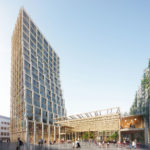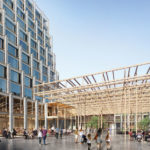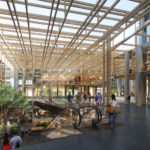NEUmarkt Bielefeld: Revitalizing Urban Retail Spaces
Project's Summary
The NEUmarkt Bielefeld project, led by Delugan Meissl Associated Architects, reimagines the concept of department stores in the modern urban landscape. Once the grand cathedrals of retail, these spaces have struggled with the rise of online shopping, leading to a need for innovative solutions. This project addresses these challenges head-on with a design that fosters urban diversity through small-scale structures. The vision is clear: to create dynamic environments that blend retail with other essential urban functions, thereby revitalizing the shopping experience.

At the heart of the NEUmarkt Bielefeld design is an ensemble of four unique structures arranged around a vibrant covered market place. This layout not only replaces the former Karstadt building but also enhances the connection between consumers and the urban fabric. Open arcades guide visitors through a seamless transition from public areas to more intimate retail experiences. The incorporation of green facades and lush greenery on the marketplace fosters a sense of community while promoting sustainable practices, making this development a green urban oasis.

The versatility of the pedestal zone is a standout feature of the NEUmarkt Bielefeld project. This innovative spatial structure accommodates a diverse array of uses including retail spaces, restaurants, services, offices, and residential apartments. Such a mix ensures that the development becomes a lively hub of activity, appealing to both locals and visitors. Strategically positioned between the bustling shopping street and the historic core, the project promises to create a strong identity that resonates with the community, enhancing the overall quality of life.

By embracing the concept of a staggered high-rise building, the NEUmarkt Bielefeld project not only provides architectural interest but also contributes to a unique urban profile. The varied heights and the thoughtfully designed courtyard-side facades evoke the feeling of a green urban sanctuary, encouraging interaction and engagement among users. This design approach reflects a commitment to sustainability and aesthetics, presenting a holistic view of modern urban living.

In conclusion, the NEUmarkt Bielefeld project stands as a beacon of innovation in the realm of urban development. It illustrates how thoughtful design can transform outdated retail spaces into vibrant, multifunctional areas that enhance community interaction and well-being. The project is a testament to the potential of architecture to respond to contemporary challenges while creating inviting environments that celebrate urban diversity and sustainability.
Read also about the 1443 York Street - Innovative Architecture in Denver project



